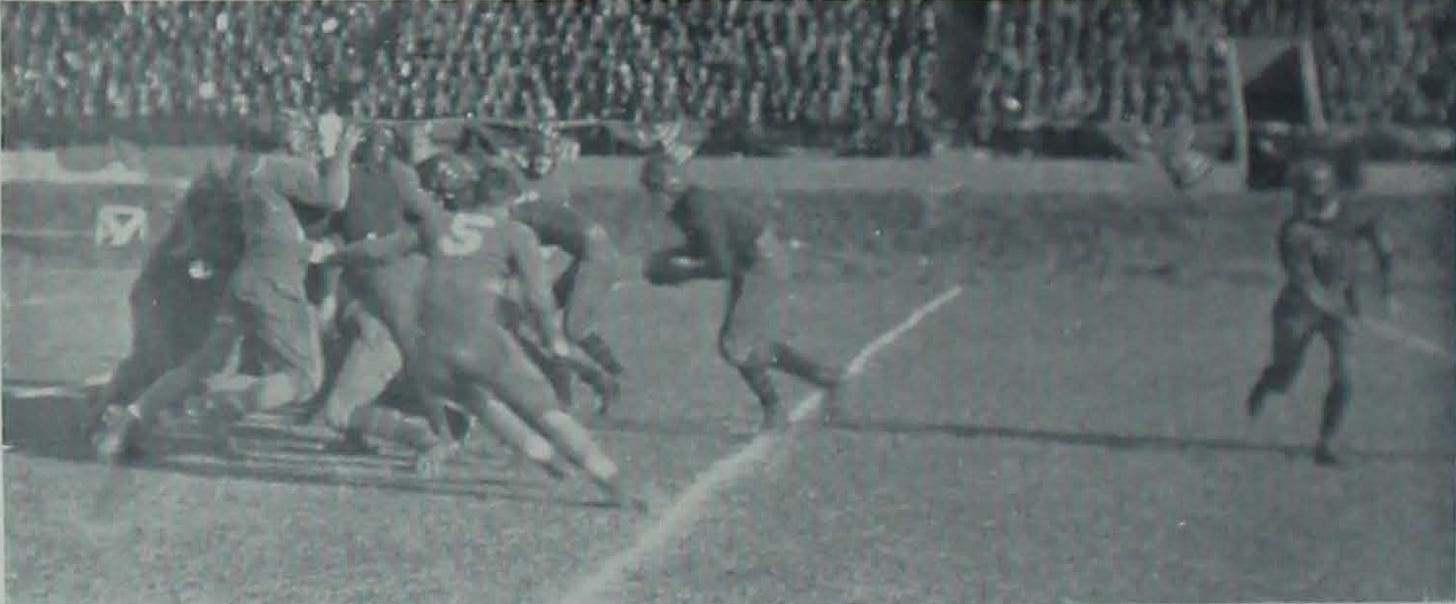Today's Tidbit... 1876 IFA Rule #42: Kickout Procedure
This is #42 in a series covering football's original 61 rules adopted by the Intercollegiate Football Association in 1876. We review one rule each Friday.
Last week we reviewed Rule 41, which defined the kickout and when it applied, and football’s later decision to distinguish safeties from touchbacks. We also covered how touchbacks evolved over time. This article addresses the kickout procedure in more detail and then covers the evolution of the safety.
Rule 42: Kick-out must be a drop kick and from not more than twenty-five yards outside the kicker's goal; if the ball when kicked-out pitch in touch, it must be taken back and kicked out again. The kicker's side must be behind the ball when it is kicked.
So, the rule tells us that kickouts occurred by a dropkick from the 25-yard line, and while teams could have kicked from closer to the goal line, it is unclear why anyone would have done so. Further, the kickout had to be kicked again when the ball went out of bounds, and the kicking team members had to be onside at the time of the kick.
With the elimination of the 55-yard line in 1912, the kick or scrimmage play following touchbacks and safeties shifted from the 25-yard line to the 20-yard line. By 1921, however, the rules makers recognized that spectators, scoreboard operators, and the press were often confused about whether the officials had called particular plays safeties or touchbacks. (The use of referee signals was in its infancy then.) Under a new rule, following safeties, they put the ball in play from the 30-yard line rather than the 20.
Last week we noted that the rules committee eliminated the option to kick the ball following a touchback in 1914, but teams retained the choice to kick or take the ball from scrimmage following safeties. However, that rule changed in 1926 due to the impetus of the 1925 Iowa State-Drake game.
In the season's second-to-last game, Iowa State visited Drake with the Missouri Valley Conference title at stake. It was a tight battle, with both teams moving the ball at times, but neither scored until Iowa State put the ball over on the first play of the fourth quarter. They converted the kick to go up 7-0.
Following the kickoff, Drake mixed passes and runs to take the ball down to Iowa State's 3-yard line, but they failed to score after three rushing attempts. With the ball on the 1-yard line, Iowa State took an intentional safety on first down, leaving the score at 7-2.
Rather than kick following the safety, Iowa State put the ball in play at the 30-yard line. Over the next four plays, the Cyclones gained a yard, lost six, and then downed the ball on the 1-yard line before taking a safety on fourth down, so the score stood 7-4 as the clock continued ticking down.
Once again, Iowa State chose not to kick but to put the ball in play from the 30-yard line. They gained 3 yards on first down and then were penalized 5 yards for stalling. On second down, the quarterback ran the ball behind his goal line to take a third consecutive safety, leaving Drake trailing by one, 7-6.
The Cyclones put the ball in play at the 30-yard line for the fourth time. On first down, the quarterback took the snap and ran around in his backfield before downing the ball on the 6-yard line as time expired, giving Iowa State a 7-6 victory.
While the Cyclones gained yardage on two plays in the sequence, their primary intention was to run out the clock, and while the tactic was legal, it did not sit well with those interested in entertaining football. As a result, the 1926 rule makers addressed the situation by eliminating the option to put the ball in play from scrimmage following a safety. The team taking the safety had to execute a free kick and do so from the 20-yard line once again. That rule has now stood for nearly a century.
Click the appropriate link for previous stories in the series:
Intro | #1 Drop Kick | #2 Place Kick | #3 Punt | #4 Goal Posts | #5 Goal | #6 Goal ≠ Punt | #7 Scoring | #8 Dead Ball | #9 Touchdown | #10 Tackle | #11 Scrimmage | #12 Ball Handling | #13 Dead Ball | #14 Scrimmage Ball Handling | #15 Run In | #16 Goal Line | #17 Boundary Lines | #18 Crying “Down” | #19 Maul In | #20 Maul in Pax | #21 Touch-in Goal | #22 Onside | #23 Offside | #24 Return to Onside | #25 Defensive Offside | #26 Throwing Back | #27 Knocking On | #28 Fair Catch | #29 Punt-out | #30 Punt-On | #31 Into Touch | #32 Inbounding | #33 Pushed Into Touch | #34 Right Angle Throw Out | #35 No Fair Catch | #36 Kickoff | #37 Kickoff Timing | #38 Change Goals | #39 Toss Up | #40 Loser Kicks | #41 Kickout
Football Archaeology is reader-supported. Click here to buy one of my books or otherwise support the site.



